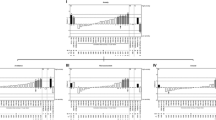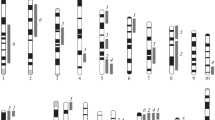Abstract
We have recently identified, using two inbred rat strains (Lewis and SHR), the first two loci for an emotionality-related behavior in rats (locomotion in the central area of the open field test). Aiming to develop an alternative genetic model that will help to corroborate the existence of these loci and that could serve as a tool in the study of anxiety, we have started breeding two new rat lines. From a highly heterogeneous population, we have selectively bred rats for four generations with high and low scores for central locomotion in the open field. At the fourth generation, the new outbred lines differed from each other for the selected trait by as much as threefold. At each generation, all rats were also tested in the elevated plus maze and the black and white box, with the two lines differing significantly also in these two models of anxiety. These results suggest that behavioral measures from different tests of emotionality/anxiety are, at least in part, genetically related. They also indicate that this newly developed genetic model (herein named Floripa H and L rat lines) may be useful in the study of anxiety, as well as serving as a tool to test the existence/significance of the two aforementioned loci putatively associated with emotionality.
Similar content being viewed by others
References
Angrini, M., Leslie, J. C., and Shephard, R. A. (1998). Effects of propanolol, buspirone, pCPA, reserpine, and chlordiazepoxide on open-field behavior. Pharmacol. Biochem. Behav., 59:387–397.
Belknap, J. K., Richards, S. P., O'Toole, L. A., Helms, M. L., and Phillips, T. J. (1997). Short-term selective breeding as a tool for QTL mapping: Ethanol preference drinking in mice. Behav. Genet., 27:55–66.
Bignami, G. (1965). Selection for high rates and low rates of avoidance conditioning in the rat. Anim. Behav. 13:221–227.
Blanchard, D. C., Griebel, G., and Blanchard, R. J. (1995). Gender bias in the preclinical psychopharmacology of anxiety: Male models for (predominantly) female disorders. J. Psychopharmacol. 9:79–82.
Broadhurst, P. L. (1962). A note on further progress in a psychogenetic selection experiment. Psychol. Rep. 10:65–66.
Broadhurst, P. L. (1975). The Maudsley Reactive and Nonreactive strains of rats: A survey, Behav. Genet. 5:299–319.
Brush, F. R., Gendron, C. M., and Isaacson, M. D. (1999). A selective genetic analysis of the Syracuse high-and low-avoidance (SHA/Bru and SLA/Bru) strains of rats (Rattus norvegicus). Behav. Brain Res. 106:1–11.
Buck, K. J., Metten, P., Belknap, J. K., and Crabbe, J. C. (1997). Quantitative trait loci involved in genetic predisposition to acute alcohol withdrawal in mice. J. Neurosci., 17:3946–3955.
Costall, B., Jones, B. J., Kelly, M. E., Naylor, R. J., and Tomkins, D. M. (1989). Exploration of mice in a black and white test box: Validation as a model of anxiety, Pharmacol. Biochem. Behav., 32:777–785.
Crabbe, J. C. (1999). Animal models in neurobehavioral genetics: Methods for estimating genetic correlation. In B. C. Jones, and P. Mormède (eds.), Neurobehavioral genetics: Methods and applications, pp. 121-138, Boca Raton: CRC Press.
Crabbe, J. C., Wahlsten, D., and Dudek, B. C. (1999). Genetics of mouse behavior: Interactions with laboratory environment. Science, 284:1670–1672.
Cruz, A. P. M., Frei, F., and Graeff, F. G. (1994). Ethopharmacological analysis of rat behavior on the elevated plus-maze. Pharmacol. Biochem. Behav., 49:171–176.
DeFries, J. C., Gervais, M. C., and Thomas, E. A. (1978). Response to 30 generations of selection for open-field activity in laboratory mice. Behav. Genet., 8:3–13.
Driscoll, P., Escorihuela, R. M., Fernández-Teruel, A., Giorgi, O., Schwegler, H., Steimer, T., Wiersma, A., Corda, M. G., Flint, J., Koolhaas, J. M., Langhans, W., Schulz, P. E., Siegel, J., and Tobeña, A. (1998). Genetic selection and differential stress responses: The Roman lines/strains of rats. Ann. NY Acad. Sci., 851:501–510.
Falconer, D. S. (1987). Introdução à genética quantitativa, p. 279, Imprensa Universitária da Universidade Federal de Viçosa, Viçosa.
Fernández-Teruel, A., Escorihuela, R. M., Gray, J. A., Aguilar, R., Gil, L., Giménez-Llort, L., Tobeña, A., Bhomra, A., Nicod, A., Mott, R., Driscoll, P., Dawson, G. R., and Flint, J. (2002). A quantitative trait locus influencing anxiety in the laboratory rat. Genome Res., 12:618–626.
Fisher, C. E., and Hughes, R. N. (1996). Effects of diazepam and cyclohexyladenosine on open-field behavior in rats perinatally exposed to caffeine. Life Sci., 58:701–709.
Fujita, O., Annen, Y., and Kitaoka, A. (1994). Tsukuba high-and low-emotional strains of rats (Rattus novergicus): An overview. Behav. Genet., 24:389–415.
Gentsch, C., Lichtsteiner, M., and Feer, H. (1987). Open field and elevated plus-maze: A behavioural comparison between spontaneously hypertensive (SHR) and Wistar-Kyoto (WKY) rats and the effects of chlordiazepoxide. Behav. Brain Res., 25:101–107.
Gray, J. A. (1979). Emotionality in male and female rodents: A reply to Archer. Br. J. Psychol., 70:425–440.
Johnston, A. L., and File, S. E. (1991). Sex differences in animal tests of anxiety. Physiol. Behav., 49:245–250.
Lander, E., and Kruglyak, L. (1995). Genetic dissection of complex traits: Guidelines for interpreting and reporting linkage results. Nature Genet., 11:241–247.
Lépine, J. P., and Lellouch, J. (1994). Classification and epidemiology of anxiety disorders. In G. Darcourt J. Mendlewicz G. Racagni, and N. Brunello (eds.). Current therapeutic approaches to panic and other anxiety disorders (Basel: Karger. pp. 1-14).
Liebsch, G., Montkowski, A., Holsboer, F., and Landgraf, R. (1998). Behavioural profiles of two Wistar rat lines selectively bred for high and low anxiety-related behaviour. Behav. Brain Res., 94:301–310.
Lobina, C., Colombo, G., Brunetti, G., Diaz, G., Melis, S., Pani, M., Serra, S., Vacca, G., Gessa, G. L., and Carai, M. A. M. (2001). Procedure of bidirectional selective outbreeding for production of two rat lines differing in sensitivity to the sedative/hypnotic effect of gama-hydroxybutyric acid. Brain Res. Prot., 8:74–81.
Maier, S. E., Vandenhoff, P., and Crowne, D. P. (1988). Multivariate analysis of putative measures of activity, exploration, emotionality, and spatial behavior in the hooded rat (Rattus novergicus). J. Comp. Psychol., 102:378–387.
Markel, A. L., Galaktionov, Y. K., and Efimov, V. M. (1989). Factor analysis of rat behavior in an open field test. Neurosci. Behav. Physiol., 19:279–286.
Mormède, P., Moneva, E., Bruneval, C., Chaouloff, F., and Moisan, M.-P. (2002). Marker-assisted selection of a neuro-behavioural trait related to behavioural inhibition in the SHR strain, an animal model of ADHD. Genes Brain Behav., 1:111–116.
Nazar, M., Jessa, M., and Plaznik, A. (1997). Benzodiazepine-GABAA receptor complex ligands in two models of anxiety. J. Neural Transm., 104:733–746.
Paulus, M. P., and Geyer, M. A. (1993). Three independent factors characterize spontaneous rat motor activity. Behav. Brain Res., 53:11–20.
Pellow, S., Chopin, P., File, S. E., and Briley, M. (1985). Validation of open:closed arm entries in an elevated plus-maze as a measure of anxiety in the rat. J. Neurosci. Methods, 14:149–167.
Plomin, R., DeFries, J. C., and McClearn, G. E. (1990). Behavioral Genetics: A Primer (2nd ed.). (p. 455). New York: W. H. Freeman.
Ramos, A., and Mormède, P. (1998). Stress and emotionality: A multidimensional and genetic approach. Neurosci. Biobehav. Rev., 22:33–57.
Ramos, A., Berton, O., Mormède, P., and Chaouloff, F. (1997). A multiple-test study of anxiety-related behaviours in six inbred rat strains. Behav. Brain Res., 85:57–69.
Ramos, A., Mellerin, Y., Mormède, P., and Chaouloff, F. (1998). A genetic and multifactorial analysis of anxiety-related behaviours in Lewis and SHR intercrosses. Behav. Brain Res., 96:195–205.
Ramos, A., Moisan, M.-P., Chaouloff, F., Mormède, C., and Mormède, P. (1999). Identification of female-specific QTLs affecting an emotionality-related behavior in rats. Mol. Psychiatry, 4:453–462.
Ramos, A., Kangerski, A. L., Basso, P. F., Santos, J. E. D. S., Assreuy, J., Vendruscolo, L. F., and Takahashi, R. N. (2002). Evaluation of Lewis and SHR rat strains as a genetic model for the study of anxiety and pain. Behav. Brain Res., 129:113–123.
Rodgers, R. J., and Cole, J. C. (1993). Anxiety enhancement in the murine elevated plus maze by immediate prior exposure to social stressors. Physiol. Behav., 53:383–388.
Simon, P., Dupuis, R., and Costentin, J. (1994). Thigmotaxis as an index of anxiety in mice: Influence of dopaminergic transmissions. Behav. Brain Res., 61:59–64.
Treit, D., and Fundytus, M. (1989). Thigmotaxis as a test for anxiolytic activity in rats. Pharmacol. Biochem. Behav., 31:59–962.
Treit, D., Menard, J., and Royan, C. (1993). Anxiogenic stimuli in the elevated plus-maze. Pharmacol. Biochem. Behav., 44:463–469.
Author information
Authors and Affiliations
Rights and permissions
About this article
Cite this article
Ramos, A., Correia, E.C., Izídio, G.S. et al. Genetic Selection of Two New Rat Lines Displaying Different Levels of Anxiety-Related Behaviors. Behav Genet 33, 657–668 (2003). https://doi.org/10.1023/A:1026131130686
Issue Date:
DOI: https://doi.org/10.1023/A:1026131130686




